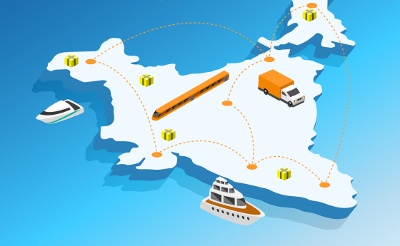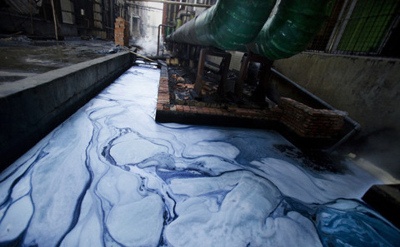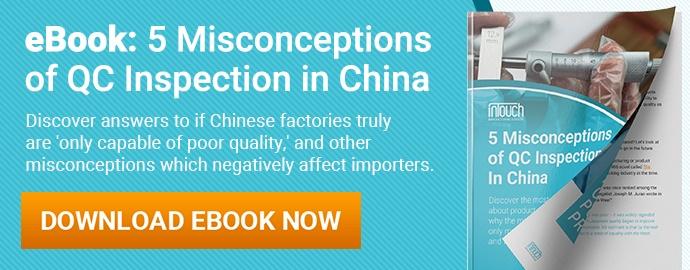Best in Manufacturing – March 25, 2018
Each Sunday, we publish a list of top articles and other content related to manufacturing in areas like quality control, product development, supply chain management, sourcing, auditing and law.
1. Serious upgrades to India’s supply chains
Infrastructure is sometimes an overlooked aspect of importing.
 Buyers may find an amazing supplier that offers great quality and prices. The supplier might also have adequate product development capabilities to support the growing needs of its customers. But what about lead times? Even with a good deal in hand, it won’t mean much if you receive your goods way past when you need them.
Buyers may find an amazing supplier that offers great quality and prices. The supplier might also have adequate product development capabilities to support the growing needs of its customers. But what about lead times? Even with a good deal in hand, it won’t mean much if you receive your goods way past when you need them.
Factory location definitely affects orders. And if your supplier is located in a region with poor infrastructure, your lead times might suffer as a result.
India is a manufacturing destination on some importers’ lists that aligns somewhat with what I’ve just described. It hasn’t had a great reputation for its infrastructure. According to S&P Global, India’s logistics and transportation bottlenecks are so serious that they hinder its GDP growth.
But that was 8 years ago. Now, there’s great potential on the horizon for the development of India’s supply chain network.
This featured article lists a host of improvements that India is poised to implement or is already in the process of implementing, such as:
- Improving regional connectivity through road, rail and inland waterways. India’s 2018 budget for infrastructure spending is about $95 billion USD
- The Sagarmala project, which aims to modernize existing ports and develop new ones
- The completion of freight corridors (estimated to be completed by December 2019)
- And more!
How India fares as a sourcing hub for importers will vary on a case-by-case basis. Comparing popular choices for manufacturing, like India versus China, will depend on what each importer needs. With these improvements to infrastructure in India, do you think importing and manufacturing will favor China, India or some other country? Let us know in the comments at the bottom of the page.
To learn more about logistics improvements in India, check out the full article in the link below:
Supply Chain in India: On the Brink of a Revolution – Rohini Singh, India Briefing
2. IBM to use tiny computers and edible invisible ink to detect counterfeits
Blockchain has already helped increased transparency into supply chains through applications like Provenance (see #4) that provide consumers and companies digital records of products as they traverse locations. Now, IBM has come up with a way to use blockchain to cut down on counterfeits.
Blockchain alone can’t identify physical counterfeits, as it’s just a digital database of information. But that’s where IBM’s “crypto-anchors” come in to link the digital world to physical products.
Crypto-anchors, which act as tamper-proof digital fingerprints, are embeddable within a product, parts of a product or even liquids. Crypto-anchors can then be used to identify a product’s origin and contents, which can then be cross-checked against a blockchain record.
Some crypto-anchors might consist of tiny computers. And by tiny, IBM means really tiny—smaller than a single grain of salt, in fact, and which IBM says will cost less than 10 cents to manufacture. Crypto-anchors can also take the form of an edible invisible ink. Revealed by a drop of water or serum, a crypto-anchor logo or mark could instantly reveal to customers whether a pill is safe to consume.
It’s hard to understate the importance of developing new methods to cut down on counterfeit goods. Counterfeit goods cost the U.S. economy an estimated $600 billion a year. But counterfeits can even cost lives. Around the world, particularly in developing countries, patients take life-saving drugs expecting a cure, but instead only receive a counterfeit, placebo pill.
These crypto-anchors haven’t hit the market yet. IBM hopes to release the first models in the next 18 months. But that isn’t stopping IBM from dreaming big. They predict crypto-anchors will cut in half the number of counterfeits linked to health and safety concerns in just five years’ time.
Check out the video embedded below or follow the link to learn more about IBM’s plans.
Nobody Likes Knockoffs. Crypto-anchors and Blockchain will Unite Against Counterfeiters – IBM Research
3. An end to manufacturing tech transfers in China?
When importing from China, there is occasionally a sense of distrust if sensitive intellectual property (IP) is exchanging hands. There are worries that the IP will be hijacked from the foreign company and monetized in the future by the Chinese supplier.
Adding to these concerns are speculations (maybe true, maybe not) that the Chinese government is financing acquisitions of foreign firms. The purchases are rumored to be a part of a massive grab of advanced IP that aligns with the Made in China 2025 initiative.
 And in addition to all the above, some companies report that in order to do business in China, there’s restricted access to the market unless they share trade secrets. These three concerns may affect some or all importers and their confidence in China.
And in addition to all the above, some companies report that in order to do business in China, there’s restricted access to the market unless they share trade secrets. These three concerns may affect some or all importers and their confidence in China.
Recently, however, Premier Li Keqiang promised that at least in the manufacturing sector, there wouldn’t be any mandatory technology transfers. For companies that have proprietary technology and products and seek to work with Chinese firms, this is welcome news.
Specifically, Li said:
We will fully open up the manufacturing sector, with no mandatory technology transfers allowed, and we will protect intellectual property.
Mats Harborn, the president of the European Chamber of Commerce in China, believes this pledge and others made by Chinese leadership could reduce the risk of entering in a trade war. But now, he believes a timeline is needed for these pledges to be enacted in order to see real progress.
How do you feel about IP protection and transfers in China? Let us know in the comments section at the bottom of the page.
If you’d like to read this featured article, check it out in the link below:
China Vows to End Forced Tech Transfers in Manufacturing Sector – Wendy Wu, South China Morning Post
4. 3D printing: not mature for full scale manufacturing…yet
3D printing generates a lot of hype. And for good reason. It’s already used to prototype goods before large production runs. The technology can build houses. 3D printing might eventually take the form of spider bots to create complex structures. Almost anywhere you look, there’s something interesting happening with 3D printing.
But does this mean it’s ready for full-scale deployment in manufacturing to fulfill entire orders?
The author of this featured article contends that 3D printing still has a ways to go before it can displace the current go-to manufacturing method, injection molding.
Sure—3D printing makes items that injection molding simply can’t. You’ve got a product with hollow spaces and abnormal geometries? No problem. 3D printing can save the day. Yet it can only make tens of these items in the time injection molding could make hundreds of a similar product.
Instead of relying on injection molding or 3D printing exclusively, these two technologies can complement each other. The author mentions, for example, that using 3D printing for the creation of injection molding tools might lead to the creation of parts that cool easier, which could reduce cycle times and costs.
The day when 3D printing replaces injection molding is uncertain. It could be right at manufacturing’s doorstep or years away. In the meantime, at the very least, these two manufacturing processes can complement each other for better operations.
To learn more about the relationship between injection molding and 3D printing, check out the full article in the link below:
3D Printing Not yet Ready to Disrupt Plastic Injection Molding – Gordon Styles, Machine Design
5. Managing water risk in supply chains
Water is sometimes referred to as “blue gold”. Potable water and water fit for industrial/commercial use is extremely valuable and in the coming decades will grow in importance. Mitigating the impact of business on water via supply chains is essential for the longevity of the planet and mankind.
 It’s necessary to consider for a moment all the ways water is used and abused. Take Xintang in Guangdong province, China, as an example. The massive scale of jean manufacturing there has turned the water in the area into a perpetual denim blue, making waterways unswimable and likely toxic.
It’s necessary to consider for a moment all the ways water is used and abused. Take Xintang in Guangdong province, China, as an example. The massive scale of jean manufacturing there has turned the water in the area into a perpetual denim blue, making waterways unswimable and likely toxic.
Another example from the denim industry: it takes roughly 10,000 liters of water on average to make a single pair of jeans (related: Reducing pollution in the denim industry, see #4).
This featured article examines operational risks in supply chains with a focus on water. The article cites the specific case of Dell managing water resources in ways beyond just product stewardship and process stewardship.
Dell decided to address issues it faces along with other stakeholders in the Tai-hu Lake catchment area in Suzhou, China by hosting a roundtable discussion. The talks represent an extra, typically government-initiated effort to managing water scarcity and ensuring it’s effectively addressed.
To verify compliance with local and national regulations pertaining to water, importers and manufacturers require increased transparency and insight into their supply chains.
In the case of China, for example, where the government recently conducted a major crackdown on pollution, China environmental protection audits serve as one method of making sure suppliers are following all the laws they should.
If you’d like to learn more about addressing water risk in your supply chain, check out the full article in the link below:
Managing Supply Chain Water Risk: New Capacities for New Challenges – Erik Davies, BSR
We’re constantly scanning the web for top manufacturing stories and news. If you’d like to submit an article for consideration for our weekly Best in Manufacturing, send us a message and let us know.







